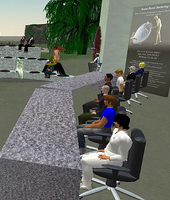Unlocking the Business Potential of Virtual Worlds
Virtual worlds have been slow to catch on in businesses — but employees familiar with the technology may help.
Topics
Social Business

Image courtesy of Flickr user John E. Lester.
For businesses, virtual worlds — computer-simulated environments in which individuals interact with one another via avatars representing their digital selves — offer a collaborative tool that has a number of possible uses, from saving money on travel and conference expenses to employee training. But despite virtual worlds’ organizational potential, their workplace usage is still low, and a number of initial attempts by companies to establish a presence in virtual worlds met with failure. The challenge for longer-term virtual world adoption by corporations lies in clearly demonstrating the technology’s business value to the organization. That business value will vary across organizations — and organizations need to find out for themselves what virtual worlds can do for them. One way to do so is through employees who are already familiar with the technology.
There are many types of virtual worlds. To make sense of the numerous platforms that exist, it is useful to visualize a continuum of virtual worlds with virtual worlds for recreational use — such as massively multiplayer online games like World of Warcraft and Guild Wars — on one end of the continuum and business-oriented, immersive environments — such as ProtoSphere and Teleplace — on the other. Somewhere in between are mixed-use virtual worlds such as ActiveWorlds and Second Life.
We argue that managers can better identify the potential business value of virtual worlds by taking advantage of some employees’ engagement with this technology outside the workplace. To provide insights for organizations on virtual world use, we surveyed more than 200 early virtual world adopters, whom we reached through an invitation to participate in the study that was sent to 700 members of a large online community of virtual worlds users. Two hundred three usable questionnaires (for a final response rate of 29%) were obtained and used for hypothesis testing. Seventy percent of the respondents were male, and respondents’ median tenure with their current employer was three to four years. The median age group was 40 to 49. Thirty percent of survey respondents had a business background, 17% had a computer science or engineering background, 13% had a social sciences background and 13% had a humanities background. Eighty-eight percent of the respondents had a bachelor’s or higher degree; 60% held a managerial position.
